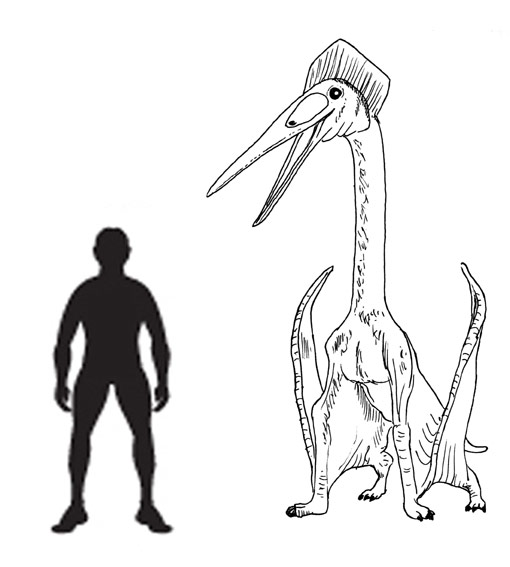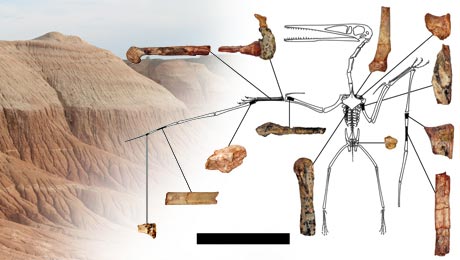Pushing the Evolution of the Pterodactyloidea Back in Time
Basal Member of the Pterodactyloidea – Kryptodrakon progenitor
Fans of the Pterosauria, that enigmatic Order of reptiles that evolved powered flight and lived alongside the Dinosauria for much of the Mesozoic are in a bit of a flap at the moment. A newly described, fragmentary pterosaur fossil found in north-west China has pushed back the evolution of the most successful group of pterosaurs, the Pterodactyloidea by another five million years.
At least one hundred and sixty three million years ago, these leathery winged creatures were soaring overhead and the Pterodactyloidea were to radiate and evolve into a huge range of different types of flying reptile. Something like 120 different genera of Pterodactyloidea have been identified so far.
Discovered in 2001
The fossil was found in 2001, it consists of some pieces from the enlarged fourth digit (the wing fingers) from the right and left wings, elements from the metacarpals, the radius, part of the left humerus and other fragmentary elements including a scapula. Although, only about 10% of the skeleton was found and no cranial material identified, the length of the fourth metacarpal in relation to the other bones that make up the forelimb places this flying reptile at the base of the pterodactyloid group of pterosaurs.
This group of pterosaurs radiated and diversified throughout the Late Jurassic and into the Cretaceous Period. They produced a myriad of forms which include the Late Cretaceous Azhdarchidae some of the largest flying creatures known to science with some species standing taller than a modern day giraffe.
The Start of Something Big!
Picture credit: Everything Dinosaur
A “Dinosaur Death Pit”
The bones were found in a “dinosaur death pit”, red mudstone strata that represents fine sediments, including volcanic ash which acted like “quicksand” trapping many animals and leaving their bodies piled up on top of each other. Such locations have revealed a “treasure trove” of fossil material, including these largely uncompressed pterosaur bones. For the international research team involved in the 2001 field study, it would have been quite a odd feeling working in what are virtually vertical bone beds, but the fossil material that has been excavated has provided a rare insight into a rich and diverse Upper to Middle Jurassic terrestrial environment.
To read more about dinosaur death pits from China: Dinosaur Death Pits Reveal Dozens of Fossils.
The fossil comes from the famous Shishugou Formation of Xinjiang Province (north-western China), the scientific paper on this new genus of flying reptile has just been published in the academic journal “Current Biology”. Lead authors of the paper include University of South Florida palaeontologist Brian Andres, James Clark of the George Washington University and Xu Xing of the Chinese Academy of Sciences.
The specimen is currently stored in the Institute of Vertebrate Palaeontology and Palaeoanthropology (Beijing). It has taken time to realise the significance of this discovery, at first the fragmentary bones were thought to be that of an unknown species of theropod dinosaur. The fossils were found in an ash bed some thirty-five metres below a layer of rock that had been dated to 161 million years ago (Bathonian/Callovian faunal stages of the Middle to Late Jurassic).
Commenting on the length of time taken to identify the specimen, a spokes person from Everything Dinosaur stated:
“It is not unusual for ten years or more to pass before a formal scientific description is published. The wealth of the fossil material being found in China leads to a backlog in the research and the importance of the discovery was not recognised at first. A basal Pterodactyloid pterosaur was not expected, not many people would have considered this possibility when the fossils were first found and catalogued.”
Kryptodrakon progenitor
The new species has been named Kryptodrakon progenitor. The genus name means “hidden dragon” a reference to the fact that the martial arts film “Crouching Tiger Hidden Dragon”, directed by Ang Lee and released in 2000 was filmed in the same locality as where the fossils were found. The trivial or species name means “ancestor”, reflecting the fact that this flying reptile has been ascribed to a basal position in the Pterodactyloidea.
Fossil Material Assigned to Kryptodrakon progenitor
Picture credit: Brian Andres
The diagram shows the fragmentary remains of Kryptodrakon progenitor found in the famed “dinosaur death pits” area of the Shishugou Formation in north-western China. The red mudstone strata from which the fossil was obtained can be seen in the background, the pterosaur skeleton used to give an impression of what this flying reptile may have looked like represents Pterodactylus antiquus (original drawing by Peter Wellnhofer). The scale bar represents five centimetres.
This pterosaur lived on a flood plain, many miles from the sea. It had been thought that pterosaurs evolved in areas that were close to the sea and that the majority of early pterodactyloid forms were fish-eaters. The discovery of the fossils of K. progenitor far inland challenges this long held assumption. It is likely that the first members of the Pterodactyloidea evolved far inland.
Phylogenetic comparative analysis of wing shape supports this theory as the research team support the idea of there being a significant correlation between wing morphology and the environment in which the animal lived. Such a strong relationship between wing shape and environmental suitability is seen in extant flying vertebrates, this indicates that pterosaurs lived in or were at least adapted to the environments represented by the strata in which their fossils have been preserved.
For models and replicas of pterosaurs and other prehistoric creatures: Schleich Prehistoric Animal Figures.
Dr Clark explained the significance of their fossil discovery:
“Kryptodrakon is the second pterosaur species we’ve discovered in the Shishugou Formation and it deepens our understanding of this unusually diverse Jurassic ecosystem. It is rare for small, delicate fossils to be preserved in Jurassic terrestrial deposits and the Shishugou fauna is giving us a glimpse of what was living alongside the behemoths like Mamenchisaurus [Sauropod dinosaur].“



